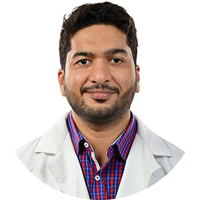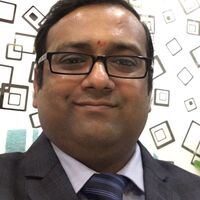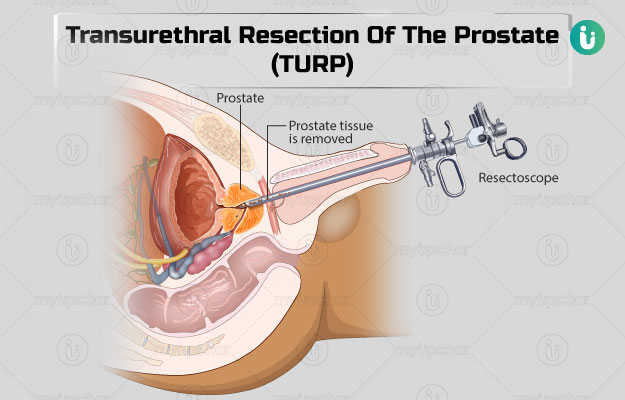Summary
Transurethral resection of the prostate (TURP) includes the surgical removal of certain parts of the prostate gland. It is done for the treatment of benign prostate hyperplasia, a condition that causes the enlargement of the prostate gland. The prostate gland resides below the urinary bladder and is coiled around the urethra, which is the tube that vacates urine from the bladder to outside the body. The enlargement of the prostate gland constricts the urethra and restricts the flow of urine, thus resulting in symptoms such as trouble in urination, frequent urination, the inability to empty the bladder and so on. In TURP surgery, the surgeon uses a long, slender instrument called a resectoscope that has an electrical wire loop, to cut the desired parts of the enlarged prostate gland. The surgery may take up to 60-90 minutes for completion. A flexible tube known as a catheter is inserted in the bladder after the surgery for draining out urine and blood. You may need to use the catheter for two to three days until your urine is clear. Depending on your condition, you may have to stay at the hospital for two days or longer. The surgery helps in improving the urine flow and providing relief from the symptoms of benign prostate hyperplasia.
- What is Transurethral resection of the prostate (TURP)?
- Why is Transurethral resection of the prostate (TURP) recommended?
- Who can and cannot get a Transurethral resection of the prostate (TURP) done?
- What preparations are needed before Transurethral resection of the prostate (TURP)?
- How is Transurethral resection of the prostate (TURP) done?
- How to care for yourself after Transurethral resection of the prostate (TURP)?
- What are the possible complications/risks of Transurethral resection of the prostate (TURP)?
- When to follow up with your doctor after a Transurethral resection of the prostate (TURP)?
What is Transurethral resection of the prostate (TURP)?
Transurethral resection of the prostate (TURP) aims to surgically remove certain sections of the prostate through the urethra (the tube in the penis that empties the urine from the bladder to outside the body).
Prostate gland is a part of the male reproductive system that resides below the urinary bladder and is coiled around the urethra. This gland assists in the production of semen (the fluid that carries the sperms). However, unusual growth of prostate gland, due to a common age-associated non-cancerous condition called benign prostate hyperplasia makes the prostate to push against the urethra. This results in narrowing the urethral passage, blocking the flow of urine.
In the TURP surgery, the surgeon inserts a slender instrument into the urethra to cut away parts of the enlarged prostate gland and remove the blockage caused by it.
Why is Transurethral resection of the prostate (TURP) recommended?
This surgery is recommended in individuals with benign prostatic hyperplasia that does not respond to medications. This condition causes the following troublesome symptoms:
- Trouble in urinating
- Frequent urination
- A continual or sudden need to urinate
- Weak flow of urine
- Forceful urination
- Inability to completely empty the bladder
- Nocturia
This surgery is also recommended for the management of prostate cancer symptoms, such as the inability to urinate.
Who can and cannot get a Transurethral resection of the prostate (TURP) done?
TURP surgery is not performed if you have any of the following conditions:
- Urinary tract infection
- Unresolved/untreated coagulopathy (bleeding disorder)
- Acute renal insufficiency (a kidney condition) caused by a blockage in the urinary bladder
If you have large stones in your urinary bladder, then a cystolitholapaxy (surgery for treating bladder stones) will be performed along with the TURP surgery.
What preparations are needed before Transurethral resection of the prostate (TURP)?
Factors such as your overall health, dimensions of your prostate gland and seriousness of symptoms will be taken into account when the surgery is scheduled. You will be asked to visit the hospital one to two weeks before the surgery for pre-operative assessment where your medical history will be reviewed and some or all of following tests will be performed:
- Blood tests
- Chest x-ray
- Electrocardiogram (to check the electrical activity of the heart)
- Screening for infections
- Urine tests
Additionally, the surgeon will ask you to:
- Share the list of all your current and previous medicines (both prescription and
- over-the-counter), supplements, vitamins and herbs.
- Discontinue taking blood-thinning medicines such as aspirin, clopidogrel, warfarin and certain herbal products one week before the surgery as these medicines alter the blood-clotting properties and increase your chances of bleeding during the procedure.
- Tell your doctor if you are allergic to any medicines, anaesthesia, tape, latex, contrast dyes, etc. Also, tell them if you have a history of bleeding disorders.
- Your doctor may ask you to stop smoking a few weeks before the surgery for faster recovery
- You may be asked to stop drinking and eating anything for eight hours prior to the surgery.
Before arriving at the hospital on the day of the surgery, ask a friend, family member or any known confidant to drive you home after the operation.
How is Transurethral resection of the prostate (TURP) done?
After admission to the hospital, the hospital staff will ask you to sign a consent form giving your approval for the procedure. You will be asked to remove your jewellery, change into a hospital gown and empty your bladder. You will be given a sedative to help you relax and decrease your anxiety before the surgery. Thereafter, you will be taken to the operating room.
The surgery is performed with a long, slender instrument called a resectoscope, a stick licke instrument with an atttached camera and an electrical wire loop. The surgery usually involves the following steps:
- You will be asked to lie on your back on the operating table.
- An anaesthesiologist will give you general anaesthesia to put you in a deep sleep.
- Your legs will be placed in the desired position with the use of medical stirrups (a frame for positioning).
- The medical/surgical team will insert a breathing tube down your throat to assist you in breathing during the surgery.
- The surgeon will then insert a resectoscope into your urethra and the proatate through your penis.
- Using the rectoscope, he/she will cut out small pieces of the enlarged prostate gland, which will then be flushed with irrigating fluid into the urinary bladder and removed through the urethra. The retroscope will be used to stop any bleeding too.
- After the desired part of the prostate is removed, the surgeon will remove the resectoscope and insert a catheter (soft, flexible tube) to drain out urine, blood or any remaining fragments of the prostate.
The procedure usually takes about 60-90 minutes. Your vital signs, that is, pulse, blood pressure and breathing, will be continuously monitored during and after the surgery. After the surgery, once your vital signs are stable, you will be taken to the recovery ward. You will have to stay at the hospital for up to two days after the surgery or longer based on your condition. You can expect the following events during your stay at the hospital:
- You will likely experience no pain after the procedure. However, if you do, then you will be given pain medicines through an intravenous line.
- Once you are awake after the surgery and you can eat or drink, you will be started on a light diet and gradually progressed to a full meal.
- A healthcare practitioner will teach you some exercises to keep up your circulation.
- If you get hematuria (blood in urine), then you will be encouraged to drink 2.5 litres of water every day. It would also help to reduce the risk of blood clots that can block the catheter.
- Immediately inform the hospital staff if you experience some discomfort, soreness or bladder spasms due to irritation caused by the catheter.
- The catheter is removed when your urine is clear, which usually takes about two to three days. However, some people find it difficult to urinate after the removal of the catheter. In such a case, a new catheter is inserted into the urethra for a few days to drain out the urine. Most people do not experience any such difficulty after the removal of the second catheter.
How to care for yourself after Transurethral resection of the prostate (TURP)?
It is normal to experience the following symptoms during the initial few weeks after the surgery:
- High frequency of urination
- Sudden feeling to urinate
- Intermittent blood in the urine (six to eight weeks)
- Pain during urination (six to eight weeks)
The surgeon may give you the following instructions to take care of yourself after the surgery:
- Diet: You should eat fibre-rich foods and increase your fluid intake to reduce straining during bowel movement.
- Constipation: Constipation is one of the after-effects of the surgery. The surgeon may prescribe medicines for the same.
- Strenuous activities: You should avoid indulging in heavy lifting or other strenuous activities for four to six weeks post-surgery as they might increase the risk of bleeding.
- Special exercises: If you experience stress incontinence (leaking urine while sneezing, laughing, coughing or exercising) post-surgery, then you will be advised pelvic floor exercises to improve your bladder control.
- Cleaning the catheter: If you are discharged with a catheter inserted in your bladder, then follow the instructions provided by the hospital to keep the cather clean.
- Sex: You should wait for about for four to six weeks before restarting sexual activity.
- Driving: You should avoid driving until your doctor allows you to.
The results achieved by the TURP surgery are long term. The surgery assists in improving urine flow and providing relief from the symptoms of benign prostate hyperplasia. Moreover, this surgery does not require any cuts to be made in the skin; therefore, there will be no scar from the surgery.
When to see the doctor?
You should call your doctor or visit the hospital if you experience any of the following symptoms after the surgery:
- Fever with a temperature over 100°F and/or chills
- Alterations in the colour and odour of urine
- Change in urine output
- Trouble passing urine
- Trouble controlling your bladder
What are the possible complications/risks of Transurethral resection of the prostate (TURP)?
The possible complications associated with this surgery are as follows:
- Bleeding
- Infection
- Pain during urination
- Bladder injury
- A slow flow of urine
- Blood in the urine
- Electrolyte imbalance
- Infection
- Stress incontinence (involuntary loss of urine)
- Erectile dysfunction (difficulty in achieving penile erection)
- Retrograde ejaculation (a condition wherein the semen goes into the bladder instead of going out of the body through the penis when you ejaculate).
- Reaction to anaesthesia or medicines
- Blood clots in legs
- Urethral stricture
- Breathing issues
When to follow up with your doctor after a Transurethral resection of the prostate (TURP)?
You will have to visit the hospital 8-12 weeks after the surgery. During the follow up the doctor will evaluate your urine flow and assess the improvements in symptoms.
Disclaimer: The above information is provided purely from an educational point of view and is in no way a substitute for medical advice by a qualified doctor.
Surgery Cost In Your City
- Transurethral resection of the prostate (TURP) cost in Kolkata
- Transurethral resection of the prostate (TURP) cost in Delhi
- Transurethral resection of the prostate (TURP) cost in Noida
- Transurethral resection of the prostate (TURP) cost in Bangalore
- Transurethral resection of the prostate (TURP) cost in Mumbai
Doctors for Transurethral resection of the prostate

Dr. Samit Tuljapure
Urology
4 Years of Experience

Dr. Rohit Namdev
Urology
2 Years of Experience

Dr Vaibhav Vishal
Urology
8 Years of Experience

Dr. Dipak Paruliya
Urology
15 Years of Experience
References
- Johns Hopkins Medicine [Internet]. The Johns Hopkins University, The Johns Hopkins Hospital, and Johns Hopkins Health System; Transurethral resection of the prostate (TURP)
- Better health channel. Department of Health and Human Services [internet]. State government of Victoria. Australia; Transurethral resection of the prostate (TURP) - for benign prostate disease
- Nemours Children’s Health System [Internet]. Jacksonville (FL): The Nemours Foundation; c2017; Male Reproductive System
- National Health Service [Internet]. UK; Transurethral resection of the prostate (TURP)
- Mount Sinai [Internet]. Icahn School of Medicine. New York. US; Transurethral resection of the prostate
- University Hospitals Birmingham [Internet]. NHS Foundation Trust. National Health Service. UK; Transurethral resection of the prostate (TURP)
- Brigham Health [Internet]. Brigham and Women's Hospital. Massachusetts. US; Transurethral resection of the prostate
- Guy's and St. Thomas' Hospital: NHS Foundation Trust [Internet]. National Health Service. UK; Having a Transurethral resection of the prostate (TURP)















